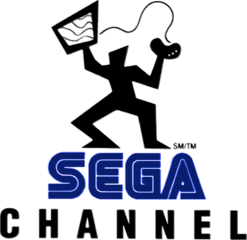Difference between revisions of "STT Video Partners"
From Sega Retro
m (→Operation) |
m |
||
| Line 27: | Line 27: | ||
===Decline and closure=== | ===Decline and closure=== | ||
| − | Despite its popularity with critics and customers alike, the [[Sega Channel]] was officially shut down on June 30, 1997. STT Video Partners' [[wikipedia:New York City, New York|New York City]] office would remain open for a brief time before closing later that year.<ref>K Horowitz (2016). ''Playing at the Next Level: A History of American Sega Games''</ref> | + | Despite its popularity with critics and customers alike, the [[Sega Channel]] was officially shut down on June 30, 1997. STT Video Partners' [[wikipedia:New York City, New York|New York City]] office would remain open for a brief time before closing later that year.<ref>K Horowitz (2016). ''Playing at the Next Level: A History of American Sega Games''</ref> |
==Press releases== | ==Press releases== | ||
*[[Press release: 1993-04-14: SEGA, TIME WARNER AND TCI JOINT VENTURE TO BRING VIDEO GAMES TO CABLE TV]] | *[[Press release: 1993-04-14: SEGA, TIME WARNER AND TCI JOINT VENTURE TO BRING VIDEO GAMES TO CABLE TV]] | ||
*[[Press release: 1993-05-20: STANLEY THOMAS NAMED PRESIDENT AND CEO OF THE SEGA CHANNEL JOINT VENTURE]] | *[[Press release: 1993-05-20: STANLEY THOMAS NAMED PRESIDENT AND CEO OF THE SEGA CHANNEL JOINT VENTURE]] | ||
| + | |||
| + | ==List of staff== | ||
| + | {{StaffList|{{PAGENAME}}}} | ||
==References== | ==References== | ||
<references/> | <references/> | ||
Latest revision as of 22:02, 24 November 2024

| ||
| STT Video Partners | ||
|---|---|---|
| Founded: 1993[1][2] | ||
| Defunct: 1997[3] | ||
| T-series code: T-148[4] | ||
Headquarters:
|
STT Video Partners, L.P. (Sega Time Warner Tele-Communications Video Partners) doing business as the Sega Channel[7][8] was an American joint venture between Sega Channel Management, Time Warner, and Tele-Communications Inc.[9][10] which oversaw both the inception and operation of the Sega Channel, as well as acting as registered owners of its trademarks.[11] Headquartered in New York City and headed by CFO Kevin Sheeran,[12][13] the company handled much of the service's marketing in the United States, and was also responsible for licensing out the Sega Channel's foreign broadcast rights.[5]
Contents
Company
Establishment

According to Sega of America key executive Joe Miller, online capabilities in the world of console gaming had been something the company had been contemplating for some time. By 1993 he felt technology had progressed to the point where such an idea would finally be viable, and fought to see it happen. Other executives, eager from the apparent success of the technological capabilities of the Sega CD, felt the same, with Doug Glen reaching out to both Time Warner and Tele-Communications Inc. in the hopes of establishing a possible joint venture to this end. These two companies had the existing consumer base, market reach, and distribution networks to make a system of television-broadcast games a reality. Thankfully, Sega found that they all shared a desire to bring games on demand to customers with home consoles.[14]
Doug Glen, alongside Ellen Beth Van Buskirk Knapp, spent months flying back and forth between Sega of America's Redwood Shores, Time Warner's New York, and TCI's Colorado, negotiating the details of the service. Their progress was reported to the Japanese Sega Enterprises, Ltd. on a regular basis. Time Warner was the first to sign onto the deal, and smoothly so. However, TCI would not be brought onboard so easily. Tom Kalinske recalls a meeting in which TCI's John Malone - an intimidating man known for his bullish tactics - surprised the executive with a next-day meeting with a TCI representative to negotiate a contract. Thankfully, Kalinske was aware TCI was in dire financial straits when going into the meeting, and although the details were undisclosed, all three companies eventually signed on to joining the deal. According to Van Buskirk Knapp, Sega of Japan had no objections to the deal.[15]
Sometime in late 1993, STT Video Partners - doing business under the name Sega Channel - was officially established by Sega Enterprises as a separate entity from Sega of America, instead operating under the Japanese side of Sega. Despite this, much of its personnel were inherited from Sega of America, including Senior Product Manager Christopher Bergstresser and Vice President of Programming Michael Shorrock. Time Warner's Stanley Thomas, Jr. was also brought onboard to serve as president and CEO. Thomas had a slightly more reserved view of games on demand services, as they were they unable to be as ad-supported as traditional television content was. Regardless, he embraced the popularity of video games, but specifically as a vehicle for expanding the influence of cable television. As a president, he was reportedly quite idealistic, mentioning to the press at Summer CES 1993 his eagerness to expand the service outside the United States before it had even launched.[16]
Curiously, as a joint venture, the company was given enough autonomy to potentially release games from competitors like Nintendo on the Sega Channel. This never came to pass, but reportedly, Nintendo of America's apathy towards the service (who had previously turned downed offers by several American cable manufacturers to create a similar system) only made STT's work in acquiring business deals that much easier. However, there were still concerns about the long-term viability of the service, especially with 32-bit consoles set to debut in only a couple years. A number of industry analysts had dismissed Sega of America's claim that a games on demand service would push physical software sales, with one critic claiming that the Sega Channel would kill the retail industry altogether. Sega stepped in to assure the industry that this would not be the case, promising to track game purchases and rental activities on 1,400 select Sega Channel subscribers and later share this information with the Video Software Dealers Association.[17]
Operation
In 1994, following successful test markets the previous year, STT launched an incredibly large marketing campaign advertising the new service.[18] The company officially licensed the Sega Channel name to all manner of promotional material, including everything from T-shirts to watches and even a novelty "Can 'O Worms" to promote Earthworm Jim.
STT Video Partners was responsible for licensing out the Sega Channel's foreign broadcast rights, such as to the Canadian SC Interactive Video, which launched the service in and around the Ontario area in May 1996.[5]
Decline and closure
Despite its popularity with critics and customers alike, the Sega Channel was officially shut down on June 30, 1997. STT Video Partners' New York City office would remain open for a brief time before closing later that year.[19]
Press releases
- Press release: 1993-04-14: SEGA, TIME WARNER AND TCI JOINT VENTURE TO BRING VIDEO GAMES TO CABLE TV
- Press release: 1993-05-20: STANLEY THOMAS NAMED PRESIDENT AND CEO OF THE SEGA CHANNEL JOINT VENTURE
List of staff
References
- ↑ Press release: 1993-04-14: SEGA, TIME WARNER AND TCI JOINT VENTURE TO BRING VIDEO GAMES TO CABLE TV
- ↑ Press release: 1993-05-20: STANLEY THOMAS NAMED PRESIDENT AND CEO OF THE SEGA CHANNEL JOINT VENTURE
- ↑ K Horowitz (2016). Playing at the Next Level: A History of American Sega Games
- ↑ https://forums.sonicretro.org/index.php?threads%2Fmore-sega-channel-prototypes-dumped.25935%2Fpage-25#post-1085772 (Wayback Machine: 2024-11-22 02:33)
- ↑ 5.0 5.1 5.2 Press Release: 1996-05-31: Shaw Launches Sega Channel in Ontario
- ↑ https://www.trademarkia.com/logomark-74526517
- ↑ https://www.sec.gov/Archives/edgar/data/750004/000075000418000011/sgms1231201710k.htm (Wayback Machine: 2023-03-07 19:05)
- ↑ https://www.linkedin.com/in/lenorewashingtongraham1/details/experience/
- ↑ https://transition.fcc.gov/transaction/aol-tw/exparte/tw_response071800.pdf (Wayback Machine: 2024-10-08 16:15)
- ↑ https://avisbudgetgroup.gcs-web.com/static-files/faf7412d-81bc-467f-b1dc-ffa281bda811
- ↑ File:SegaChannel US Flyer 1997-08-15 1997-09-11.pdf, page 2
- ↑ http://www.f-cca.com/downloads/2008-highlights.pdf (Wayback Machine: 2013-05-24 18:54)
- ↑ https://www.pgridigitallibrary.com/uploads/4/3/1/5/43157305/sheehan_kevin_september-october_2016.pdf (Wayback Machine: 2024-07-05 00:01)
- ↑ K Horowitz (2016). Playing at the Next Level: A History of American Sega Games
- ↑ K Horowitz (2016). Playing at the Next Level: A History of American Sega Games
- ↑ K Horowitz (2016). Playing at the Next Level: A History of American Sega Games
- ↑ K Horowitz (2016). Playing at the Next Level: A History of American Sega Games
- ↑ K Horowitz (2016). Playing at the Next Level: A History of American Sega Games
- ↑ K Horowitz (2016). Playing at the Next Level: A History of American Sega Games